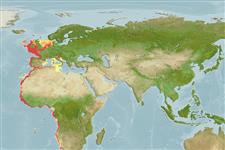Issue
Questionable synonym Arnoglossus blachei Stauch, 1965 is a valid species according to Fricke et al., 2023 (Ref. 128433). Pending correction in FishBase.
Environment: milieu / climate zone / depth range / distribution range
Ökologie
seewasser demersal; tiefenbereich 20 - 350 m (Ref. 26999), usually 40 - 200 m (Ref. 36731). Subtropical; 58°N - 29°S, 19°W - 22°E
Eastern Atlantic: Scotland to Namibia (Ref. 27121), including the western Mediterranean.
Size / Gewicht / Alter
Maturity: Lm ? range ? - ? cm
Max length : 25.0 cm TL Männchen/unbestimmt; (Ref. 2683); common length : 12.0 cm TL Männchen/unbestimmt; (Ref. 3397)
Rückenflossenstacheln (insgesamt) : 0; Rückenflossenweichstrahlen (insgesamt) : 95 - 106; Afterflossenweichstrahlen: 74 - 82. Eyes separated by a bony ridge, the lower eye a little in advance of the upper. In males, the second to sixth and in females, the second to fifth dorsal fin rays thickened and prolonged. Males with distinct black spot on posterior part of pelvic fins; in females, this spot present but greyish and often indistinct.
Found on sand, mud, shell and corals (Ref. 27121). Caught with bottom and pelagic trawls (Ref. 2683).
Life cycle and mating behavior
Geschlechtsreife | Fortpflanzung | Ablaichen | Eier | Fecundity | Larven
Aldebert, Y., M. Desoutter and J.-C. Quéro, 1990. Bothidae. p. 1027-1036. In J.C. Quero, J.C. Hureau, C. Karrer, A. Post and L. Saldanha (eds.) Check-list of the fishes of the eastern tropical Atlantic (CLOFETA). JNICT, Lisbon; SEI, Paris; and UNESCO, Paris. Vol. 2. (Ref. 5979)
IUCN Rote Liste Status (Ref. 130435: Version 2024-1)
Bedrohung für Menschen
Harmless
Nutzung durch Menschen
Fischereien: kommerziell
Tools
Zusatzinformationen
Download XML
Internet Quellen
Estimates based on models
Preferred temperature (Ref.
123201): 9.8 - 19.2, mean 11.7 °C (based on 340 cells).
Phylogenetic diversity index (Ref.
82804): PD
50 = 0.5000 [Uniqueness, from 0.5 = low to 2.0 = high].
Bayesian length-weight: a=0.00589 (0.00391 - 0.00887), b=3.11 (2.99 - 3.23), in cm total length, based on LWR estimates for this species & Genus-body shape (Ref.
93245).
Trophic level (Ref.
69278): 3.8 ±0.60 se; based on food items.
Widerstandsfähigkeit (Ref.
120179): mittel, Verdopplung der Population dauert 1,4 - 4,4 Jahre. (Preliminary K or Fecundity.).
Fishing Vulnerability (Ref.
59153): Low vulnerability (15 of 100).
Nutrients (Ref.
124155): Calcium = 95.5 [46.4, 217.0] mg/100g; Iron = 1.01 [0.47, 1.79] mg/100g; Protein = 18.5 [17.0, 19.9] %; Omega3 = 0.327 [0.143, 0.642] g/100g; Selenium = 28.9 [15.2, 60.6] μg/100g; VitaminA = 20 [6, 62] μg/100g; Zinc = 0.785 [0.542, 1.118] mg/100g (wet weight);
